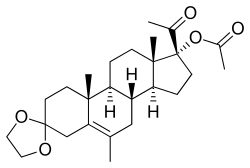Edogestrone
Edogestrone (INN, BAN) (developmental code name PH-218), or edogesterone, also known as 17α-acetoxy-3,3-ethylenedioxy-6-methylpregn-5-en-20-one, is a steroidal progestin and antiandrogen of the 17α-hydroxyprogesterone group which was synthesized in 1964 but was never marketed.[1][2] Similarly to the structurally related steroid cyproterone acetate, edogestrone binds directly to the androgen receptor and antagonizes it, displacing androgens like testosterone from the receptor, though not as potently as cyproterone acetate.[3] The drug has also been found to suppress androgen production, likely via progesterone receptor activation-mediated antigonadotropic activity.[4]
 | |
| Clinical data | |
|---|---|
| Other names | Edogesterone; PH-218; 17α-Acetoxy-3,3-ethylenedioxy-6-methylpregn-5-en-20-one |
| Drug class | Progestogen; Progestogen ester |
| Identifiers | |
IUPAC name
| |
| CAS Number | |
| PubChem CID | |
| ChemSpider | |
| UNII | |
| Chemical and physical data | |
| Formula | C26H38O5 |
| Molar mass | 430.57692 g/mol g·mol−1 |
| 3D model (JSmol) | |
SMILES
| |
InChI
| |
See also
References
- J. Elks (14 November 2014). The Dictionary of Drugs: Chemical Data: Chemical Data, Structures and Bibliographies. Springer. pp. 478–. ISBN 978-1-4757-2085-3.
- Geller, J.; McCoy, K. (1974). "BIOLOGIC AND BIOCHEMICAL EFFECTS OF ANTI-ANDROGENS ON RAT VENTRAL PROSTATE". European Journal of Endocrinology. 75 (2): 385–397. doi:10.1530/acta.0.0750385. ISSN 0804-4643.
- Elinor Spring-Mills; Elsayed Saad Eldin Hafez (1 January 1980). Male accessory sex glands: biology and pathology. Elsevier/North-Holland Biomedical Press. p. 500.
- J.E. Castro (9 March 2013). The Treatment of Prostatic Hypertrophy and Neoplasia. Springer Science & Business Media. pp. 39–. ISBN 978-94-015-7190-6.
Geller has also demonstrated significant decreases in plasma or urine testosterone glucuronide levels following the administration of three other anti-androgens. These include Delalutin, Chlormadinone acetate, and PH-218. It would appear that decreased androgen production is a property shared by all anti-androgens to date.
This article is issued from
Wikipedia.
The text is licensed under Creative
Commons - Attribution - Sharealike.
Additional terms may apply for the media files.